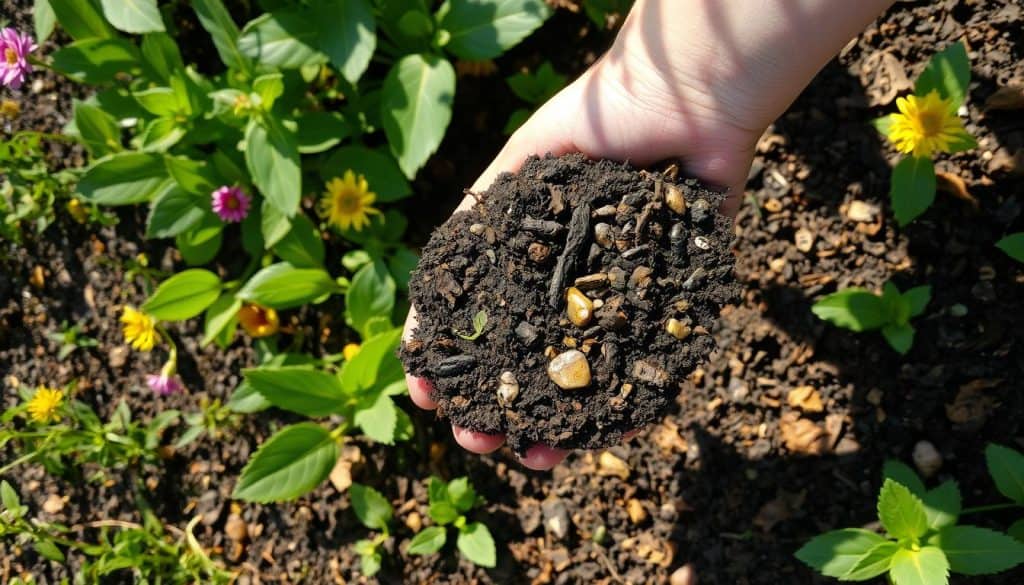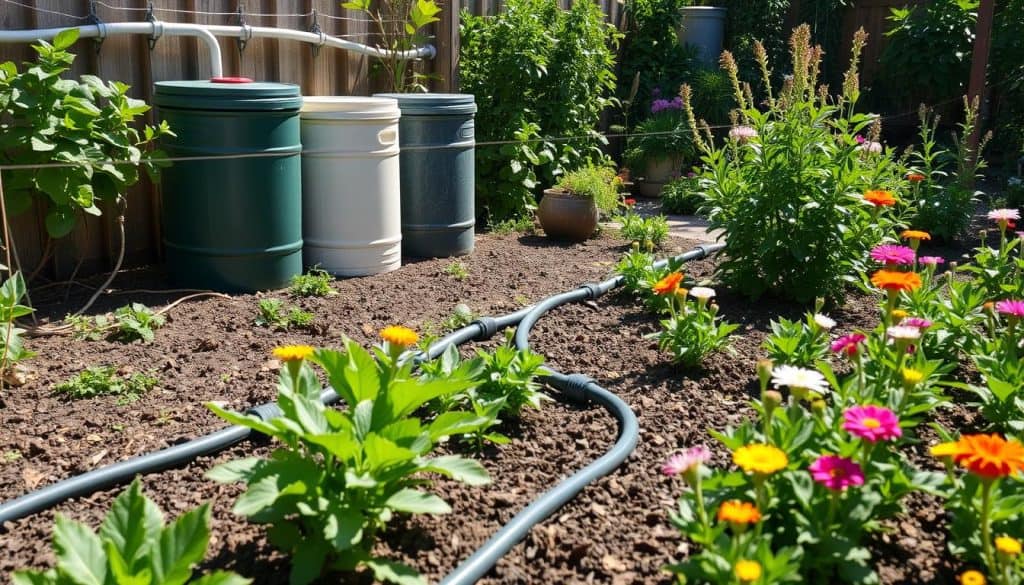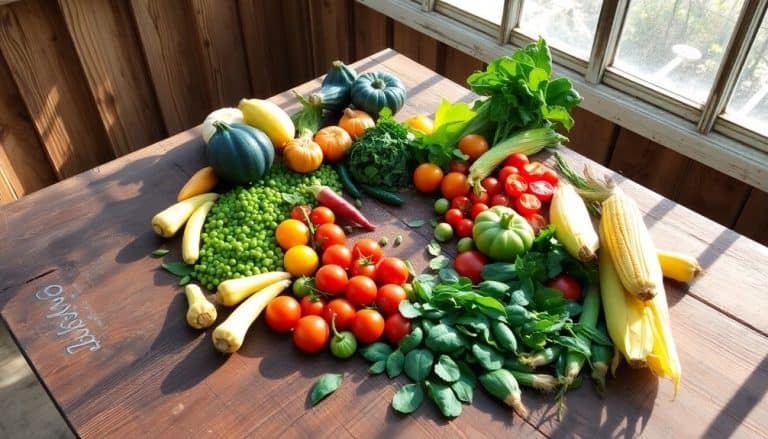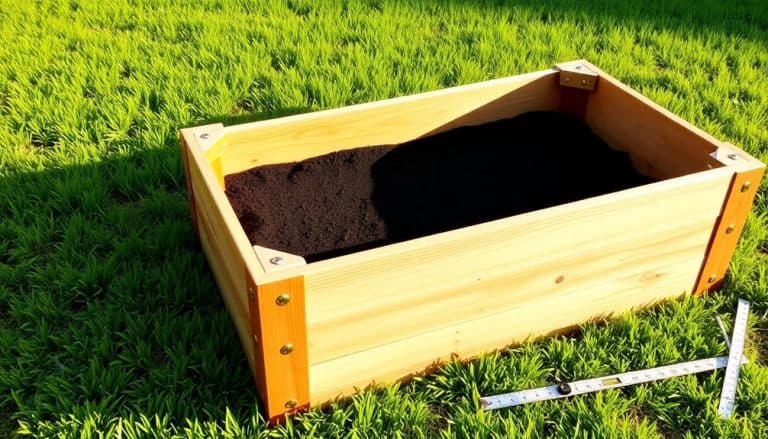This website contains affiliate links. Some products are gifted by the brand to test. As an Amazon Associate, I earn from qualifying purchases. The content on this website was created with the help of AI.
Organic gardening is gaining popularity in America. 35% of households now grow food at home or in community gardens. People are embracing natural methods to grow chemical-free vegetables and create garden ecosystems.
Starting an organic garden is simpler than you might think. Natural techniques help you grow tasty produce and nurture a thriving ecosystem. This guide covers the basics, from choosing a location to maintaining healthy soil.
You don’t need a large space for an organic garden. Even 50 square feet can yield various vegetables. Choose the right plants and care for them properly.
Old-fashioned pole beans, zucchini, and Swiss chard are great for beginners. These vegetables are easy to grow and maintain.
Soil health is crucial in organic gardening. Quality compost provides essential nutrients and improves soil structure. This natural approach benefits plants and supports the entire garden ecosystem.
Key Takeaways
- 35% of American households grow food at home or in community gardens
- Organic gardening focuses on natural methods without synthetic chemicals
- A small 50 square foot area is enough to start an organic garden
- Easy-to-grow vegetables for beginners include pole beans and zucchini
- Quality compost is essential for building healthy soil in organic gardens
- Organic gardening supports a thriving garden ecosystem
Understanding Organic Gardening for Beginners
Organic gardening means growing plants without synthetic chemicals. It works with nature to create a healthy garden ecosystem. Let’s explore organic gardening basics and benefits.
What Makes a Garden Organic
Organic gardens follow USDA Organic standards. This means no synthetic fertilizers, pesticides, or GMOs. Instead, you’ll focus on soil health and diverse crops.
Compost is key in chemical-free gardening. It’s at the heart of this natural approach.
Benefits of Growing Your Own Food
Growing your own food organically offers numerous advantages:
- Healthier, fresher produce
- Environmental stewardship
- Connection with nature
- Cost savings on groceries
- Control over what goes into your food
Basic Organic Gardening Principles
To start your organic garden, follow these key principles:
- Build healthy soil with compost and organic matter
- Choose plants suited to your climate
- Practice crop rotation to prevent pest buildup
- Use natural pest control methods
- Conserve water through mulching and efficient irrigation
| Aspect | Organic Gardening | Conventional Gardening |
|---|---|---|
| Fertilizers | Compost, organic matter | Synthetic chemicals |
| Pest Control | Natural methods, companion planting | Chemical pesticides |
| Soil Health | Emphasis on soil biology | Focus on nutrient levels |
| Environmental Impact | Low | Higher |
These principles help create a thriving, chemical-free garden. Your organic garden will produce healthy food and support the environment.
Choosing the Perfect Garden Location
The right garden spot is crucial for a thriving organic garden. Sunlight, soil quality, and space all play vital roles. These factors determine your plants’ success.
Assessing Sunlight Requirements
Most veggies need lots of sunshine to grow well. Find a spot with at least 6 hours of direct sunlight daily. Leafy greens can manage with less sun.
Fruiting plants like tomatoes and peppers need more sunlight. Check your yard at different times to find the sunniest areas.
Understanding Microclimates
Your yard has unique microclimates created by buildings, trees, and slopes. These areas affect temperature, wind, and moisture. Look for spots sheltered from strong winds but with good air flow.
Avoid low-lying areas where frost settles. This can harm early spring or late fall crops.
Evaluating Space Options
Think about your available space and gardening goals. In-ground beds work well for larger areas. Raised beds offer better soil control.
Container gardens are great for small spaces or patios. Some plants spread out as they grow. Bush varieties of squash and beans take up less room.
Plan for proper spacing to ensure good air circulation and sunlight exposure.
- Start small with easy crops like lettuce, radishes, and herbs
- Ensure easy access to water
- Check soil drainage to avoid water pooling
- Keep garden away from tree roots that might compete for nutrients
A well-chosen garden spot sets the stage for a great harvest. Watch your yard and think about these factors before planting. Your efforts will lead to healthy, productive plants all season long.
Essential Tools and Materials for Getting Started
Your organic garden journey needs a few key tools and equipment. Let’s explore the essentials for cultivating your green space successfully.
Protective gear is crucial for first-year gardeners. Garden gloves, waterproof boots, and kneeling pads are essential. Wonder Grip Nitrile Garden Gloves offer great protection and dexterity.
Quality hand tools are a must-have. A stainless-steel hand shovel is durable and efficient. The Rogue Garden Hoe 575G is versatile with its tempered steel head.
Watering equipment is vital for plant care. Choose from watering cans, hoses, or watering wands. Hose diameters affect water flow rates. The Tuff-Guard Hose resists kinks effectively.
| Tool Category | Essential Items | Recommended Brands |
|---|---|---|
| Protective Gear | Gloves, Boots, Kneeling Pads | Wonder Grip, Slogger |
| Hand Tools | Shovel, Hoe, Pruner | Rogue, Barnel |
| Watering Equipment | Hose, Nozzle, Watering Can | Tuff-Guard, Bon Aire |
| Planting Aids | Containers, Stakes, Twine | Grow Bags, Self-Watering Containers |
Garden kits are great for beginners. Self-watering containers or Grow Bags make plant care easier. Don’t forget stakes or trellises for climbing plants, and twine for support.
A garden planner helps track your progress. The Beginner’s Garden Shortcut online course offers valuable insights into organic gardening techniques. It also teaches proper use of garden equipment.
Building Healthy Organic Soil
Healthy soil is crucial for organic gardening success. Your plants thrive when they grow in high-quality earth. Let’s discover how to create the best foundation for your garden.
Soil Testing and Preparation
Test your soil to learn its makeup and pH. The best organic soil has 40% sand, 40% silt, and 20% clay. This mix, called loam, drains well and holds nutrients.
Check for compaction, depth, and drainage. These factors give a full picture of your soil’s health.

Composting Basics
Composting creates nutrient-rich soil amendments. Mix kitchen scraps and yard waste to make dark humus. This natural fertilizer boosts soil structure and moisture retention.
Compost also introduces helpful microorganisms. Every teaspoon of healthy soil contains billions of these tiny helpers!
Natural Soil Amendments
Enrich your organic soil with natural additions. Coffee grounds, banana peels, and eggshells work well. For clay-heavy soil, use gypsum instead of sand to improve drainage.
Gypsum creates air pockets, letting roots breathe. Try cover crops like buckwheat or clover to boost soil with low organic matter.
- Add 2-3 inches of organic matter to improve clay soils
- Use mulch to protect topsoil from erosion
- Rotate crops to prevent nutrient depletion
- Minimize chemical pesticides to preserve beneficial soil life
Good soil should have 25% air and 25% water. Focus on building organic soil for a thriving, bountiful garden.
Planning Your Garden Layout
A well-planned garden layout is crucial for a thriving growing season. Various designs suit different spaces, from small patios to large backyards. Let’s explore some popular options for your perfect garden layout.
Raised Beds vs. In-Ground Planting
Raised beds provide excellent soil control and drainage. They’re perfect for small spaces or areas with poor soil. In-ground planting suits larger areas and offers more design flexibility.
Plan for 50 square feet of garden space per person you’re feeding. This guideline helps ensure enough produce for your needs.
Container Gardening Options
Container gardening is ideal for patios, balconies, or limited spaces. You can grow various plants in pots, hanging baskets, or repurposed items. This method works great for herbs, small vegetables, and flowers.
Space-Saving Garden Designs
Vertical gardening maximizes space efficiently. Use trellises, wall-mounted planters, or stackable containers to grow upwards. This technique is perfect for vining plants like cucumbers, peas, and some squash varieties.
Vegetables need at least 6 hours of full sun daily. Place sun-loving plants in the brightest spots for optimal growth. Keep a garden journal to track plant placement and results.
This record will help you improve your garden layout each year. You’ll learn from past successes and failures to create better designs.
Selecting and Starting Plants
Choose plants that suit your climate for a thriving organic garden. Look for disease-resistant varieties bred for your region. This approach ensures better success and less frustration.
Organic seeds are best for gardening. They align with organic principles and produce healthier plants. Start some indoors to extend your growing season.
For quicker results, beginners can buy healthy plant starts. Mix vegetables, herbs, and flowers to create a diverse garden ecosystem.
This variety attracts beneficial insects and supports plant health. Consider easy-to-grow options like lettuce, beans, tomatoes, basil, and sunflowers.
- Vegetables: Lettuce, green beans, radishes, tomatoes
- Herbs: Basil, cilantro, mint
- Flowers: Sunflowers, marigolds, zinnias
Most vegetables need 6-8 hours of direct sunlight daily. Plan your garden layout accordingly. A 10×10-foot area is good for in-ground planting.
For raised beds, start with a 4×4-foot or 4×8-foot size. Focus on proper plant selection and seed starting techniques.
With time and care, you’ll enjoy fresh, organic produce from your backyard. Your garden will grow strong and yield a bountiful harvest.
Natural Pest Control and Disease Management
Organic gardening relies on keeping your garden healthy without harmful chemicals. Let’s explore effective strategies for organic pest control and disease prevention.
Companion Planting Strategies
Companion planting deters pests naturally by pairing certain crops together. This method confuses or repels harmful insects. For example, planting marigolds near tomatoes helps keep pests away.
A diverse garden with various blooming flowers attracts beneficial insects. These helpful bugs eat garden pests, creating a natural balance.
Organic Pest Solutions
Neem oil is a top choice for organic pest control. It works as both a repellant and suppressant for many garden pests.
Diatomaceous earth (DE) effectively controls hard-shelled bugs. Another option is pyrethrin, made from chrysanthemum flowers. It quickly kills many insects.
Prevention Methods
Prevention is your best defense against garden pests and diseases. Start with pest-free plants and clean tools. Rotate your crops to discourage diseases.
Maintain healthy soil based on soil tests. In fall, clean up garden debris to prevent pests from overwintering.
Clean trellises and supports during freezing temperatures. This helps kill off diseases that may linger on surfaces.
| Prevention Method | Benefit |
|---|---|
| Crop Rotation | Discourages disease buildup |
| Soil Testing | Ensures proper fertility for pest resistance |
| Fall Clean-up | Prevents overwintering pests |
| Tool Disinfection | Stops disease spread |
A healthy garden is your best defense against pests and diseases. These organic methods will help you create a thriving, pest-free garden.
Water Management and Conservation
Smart water use is vital for organic gardening success. Only 3% of Earth’s freshwater is available for humans. Adopting clever practices helps conserve water in your garden.
Watering Techniques
Water deeply but less often to promote deep root growth. Check soil moisture before watering by inserting your finger 1 inch deep. Target the plant base to keep leaves dry.
Water between 9 pm and 6 am to reduce evaporation. This timing allows more water to soak into the soil.

Mulching Methods
Mulching is a powerful water-saving tool. Apply a 2″ to 3″ layer of organic mulch around plants. This can halve water needs and suppress weeds.
Mulching also improves soil health. Increasing soil organic matter by 5% can quadruple its water-holding ability.
Irrigation Systems
For bigger gardens, try drip irrigation or soaker hoses. These can cut water use by half compared to traditional methods. Drip irrigation applies water directly to roots, boosting efficiency to 90%.
| Watering Method | Water Efficiency | Benefits |
|---|---|---|
| Traditional Sprinklers | 50-70% | Easy to install, covers large areas |
| Soaker Hoses | Up to 80% | Reduces evaporation, targets root zone |
| Drip Irrigation | Up to 90% | Precise water delivery, minimal waste |
Using these water-saving methods creates a more sustainable organic garden. You’ll protect our precious water resources while growing healthy plants.
Maintaining Your Organic Garden
A thriving organic garden requires regular care. Smart garden maintenance practices are key to success. Crop rotation is essential for preventing soil depletion and pest problems.
Move plant families to different spots each year. Rotate about 20% of your crops annually. This strategy helps maintain soil health and productivity.
Feeding your plants is crucial for growth. Use organic fertilizers like compost tea or seaweed extract. These natural options nourish both the soil and plants.
Fertilize once a month during the growing season. Allocate 10% of your garden budget for soil testing and amendments. This investment ensures optimal plant health.
Keep your garden clean and disease-free. Remove debris and diseased plants promptly. Clean your tools often to prevent disease spread.
Check your garden weekly for pests and diseases. Early detection makes control easier. Water your plants in the early morning for best absorption.
Harvest regularly to encourage more production. This practice keeps your garden productive throughout the season. Enjoy the fruits of your labor!




